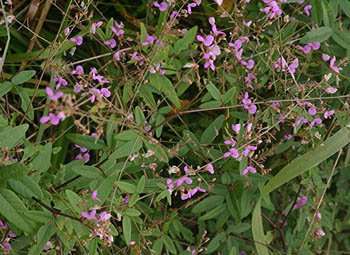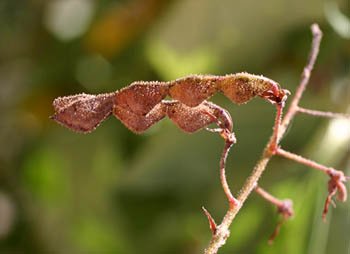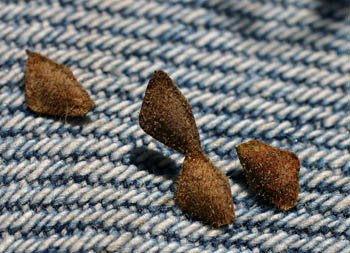





It is said that velcro was a by-product of the space industry. However, Mother Nature was probably the inspiration, since her velcro has been around for millions of years.
Several years ago, relatives from Europe were visiting and being outdoorsy folks, we explored the fields and forests of western Kentucky. After one such excursion, my guest looked down at her socks that were covered with small oval spots that looked like bugs and asked what they were. “Those are just beggar-lice,” I replied. “LICE!!!” (the look of horror on my Scandinavian cousin's face was priceless) I began to laugh and explained they were not actually lice, but seeds from an interesting plant.
 The genus Desmodium consists of over 75 species of plants that have the unique capability of hitching a ride on any passer-by. The small seeds are covered in fine hairs that attach themselves to clothing and fur to get free transport to other areas. The pretty little flowers look like miniature sweet peas and that is no coincidence, since both are legumes in the Fabaceae family. Most are either annual or short-lived perennials. However, their prolific production of seeds ensures that there are always plenty of plants. This is good, because the high protein content makes them very attractive to game birds like quail and of course deer find them tasty as well. They like them as well as soybeans, although the deer usually find soybeans conveniently planted in easy to browse fields with rows. In fact, many land owners who plant brood crops to attract game, make sure that Desmodiums are included in the mix.
The genus Desmodium consists of over 75 species of plants that have the unique capability of hitching a ride on any passer-by. The small seeds are covered in fine hairs that attach themselves to clothing and fur to get free transport to other areas. The pretty little flowers look like miniature sweet peas and that is no coincidence, since both are legumes in the Fabaceae family. Most are either annual or short-lived perennials. However, their prolific production of seeds ensures that there are always plenty of plants. This is good, because the high protein content makes them very attractive to game birds like quail and of course deer find them tasty as well. They like them as well as soybeans, although the deer usually find soybeans conveniently planted in easy to browse fields with rows. In fact, many land owners who plant brood crops to attract game, make sure that Desmodiums are included in the mix.
 This plant has a number of common names, all refer to its ability to adhere to fur and clothing. Stick-tights, tick-trefoil and beggar ticks are just a few of the names folks have given this sticky little seed. (there are other names that shouldn't be mentioned in polite company)The stiff hairs clasp on to any textile or type of animal fur and are difficult to remove. If your dog ends up with a batch of them, sometimes the only way to remove them is teasing them out of the fur one by one. (ask me how I know this) Humans can scrape them off of tightly woven cloth with a knife held at about a 45 degree angle, however items such as socks and sweaters require the one at a time method, just like your pet.
This plant has a number of common names, all refer to its ability to adhere to fur and clothing. Stick-tights, tick-trefoil and beggar ticks are just a few of the names folks have given this sticky little seed. (there are other names that shouldn't be mentioned in polite company)The stiff hairs clasp on to any textile or type of animal fur and are difficult to remove. If your dog ends up with a batch of them, sometimes the only way to remove them is teasing them out of the fur one by one. (ask me how I know this) Humans can scrape them off of tightly woven cloth with a knife held at about a 45 degree angle, however items such as socks and sweaters require the one at a time method, just like your pet.
Desmodiums prefer, sunny, well-drained meadows and will form loose colonies where quail love to hang out. They bloom from late summer into fall and the mature seeds generally drop to the ground where ground-dwelling birds and small mammals find a tasty feast. The seeds are edible for humans as well, but it takes a great number to amount to a significant meal. The taste has been described as similar to soybeans.
 Early folk medicine brewed a tea from the leaves and stems to reduce fever, treat rheumatism and coughs, although there are a number of wild plants that are more effective than this one. It is also not noted as a toxic plant, so should be considered safe for small children and pets to be around as well.
Early folk medicine brewed a tea from the leaves and stems to reduce fever, treat rheumatism and coughs, although there are a number of wild plants that are more effective than this one. It is also not noted as a toxic plant, so should be considered safe for small children and pets to be around as well.
This interesting little native plant would be a great addition to a prairie restoration or natural meadow. The small flowers are not very showy from a distance, so it is best to include it in a grouping if you intend to use it with your bedding plants. Bees, butterflies and hummingbirds find the beggar lice flowers attractive, so do consider it if you plant a pollinator or wildlife garden.
Copyright © www.100flowers.win Botanic Garden All Rights Reserved